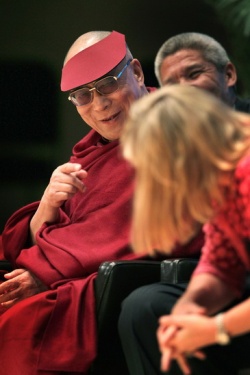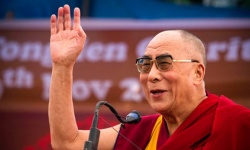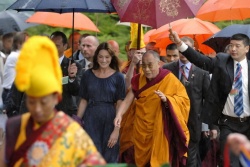China Creates Specter of Dueling Dalai Lamas
June 6, 2009
DHARAMSALA, India — For centuries, the selection of the reincarnation of the Dalai Lama has been steeped in the mysticism of a bygone world. On the windswept Tibetan plateau, his closest aides look for divinations in a sacred lake. A mountain god transmits oracular messages by possessing a high lama. Monks scour villages for boys precocious in their spiritual attunement.
All that is about to change, as the current Dalai Lama and his followers in exile here in India compete with the Chinese government for control of how the 15th Dalai Lama will be chosen. The issue is urgent for the Tibetans because the current Dalai Lama, the spiritual leader of all Tibetans and the charismatic face of the exile movement, has had recent bouts of ill health. He turns 74 in July.
Both the Chinese and the Tibetan exiles are bracing for an almost inevitable outcome: the emergence into the world of dueling Dalai Lamas — one chosen by the exiles, perhaps by the 14th Dalai Lama himself, and the other by Chinese officials.
“It’s a huge but ultracritical issue, with no clear outcome or solution except one: trouble,” said Robert Barnett, a Tibet scholar at Columbia University. “It is going to end up with two Dalai Lamas and thus with long-running conflict, unless the Chinese agree to a diplomatic solution pretty soon.”
The jockeying has put the Dalai Lama and the Chinese Communist Party in surprising positions. The Dalai Lama said late last month in an interview with The New York Times that all options for choosing his reincarnation were open, including ones that break from tradition. That could mean that the next Dalai Lama would be found outside Tibet, could be a woman or might even be named while the 14th Dalai Lama was still alive, before his soul properly transmigrated. Meanwhile, the party, officially atheist and accused of ravaging Tibetan culture, insists that religious customs must be followed.
A traditional selection process would be easily controlled by the Chinese government, since the process is rooted in the landscape of Tibet, which the Chinese seized in 1951. China has already positioned itself in other ways, including enacting a law in 2007 that says all reincarnations of senior lamas must be approved by the government.
Here in Dharamsala, India, where the Dalai Lama lives, religious leaders have been debating whether to bypass the traditional process. Meanwhile, many Tibetans say they will honor whatever the Dalai Lama decides to do.
“This is a religious matter,” the Dalai Lama said in the interview. “Of course there’s a political implication there, but it’s mainly a religious matter, spiritual matter, so therefore I have to discuss it with leaders, spiritual leaders.”
The figure of the Dalai Lama, head of the Gelugpa sect of Tibetan Buddhism, is without rival in influence among Tibetans and many Buddhists worldwide. He is revered as the reincarnation of Chenrezig, a deity who has chosen to remain on earth to help people achieve enlightenment. Many of China’s six million Tibetans keep photos of him in their mud-walled homes, monasteries and nomadic tents, or hidden in the folds of their clothes, even though the government has outlawed all images of the Dalai Lama, who fled Tibet in 1959.
The Chinese government accuses the Dalai Lama of being a separatist, though he demands only genuine autonomy for Tibet.
The Communist Party, aware that Buddhism is central to Tibetans, has tried to select and prop up lamas who will support the government while still retaining legitimacy among the people.
In 1995, when the Dalai Lama confirmed a boy in Tibet as the reincarnation of the Panchen Lama, the second-ranking leader of the Gelugpa sect, the Chinese government whisked away the boy and his parents and installed its own child lama. The Dalai Lama’s choice, Gedhun Choekyi Nyima, now 20, is still hidden from public view, while the government’s selection shows up at official events to praise Communist policy — and is seen by many Tibetans as a fraud.
Chinese leaders also tried to groom the Karmapa, the reincarnated head of the Kagyu sect, but he fled to India in 1999, at age 14. He now sits by the Dalai Lama at prayer ceremonies here.
“This is one of the chief indicators that China has failed in Tibet,” said Mr. Barnett, the Columbia scholar. “It’s failed to find consistent leadership in Tibet by any Tibetan lama who is really respected by Tibetan people, and who at the same time endorses Communist Party rule.”
Chinese officials are hoping that will change with their selection of the next Dalai Lama. Lian Xianming, a scholar at the China Tibetology Research Center, a government-supported institution in Beijing, said that since the Qing Dynasty, which began in the 17th century, all reincarnations of the Dalai Lama and Panchen Lama required approval by Beijing after going through the traditional method of selection. “The real Dalai Lama will be the one who has gone through the historical process,” he said.
That was the process used to find the current one. After the death of the 13th Dalai Lama in 1933, senior lamas journeyed on horseback to the sacred lake of Lhamo Lhatso, not far from Lhasa, the Tibetan capital. There, they said, they received a vision that pointed to eastern Tibet as the site where the reincarnation would be found. Earlier, a medium of the Nechung Oracle, the mountain god that serves as the state fortuneteller, was said to have turned eastward in a trance.
Three search parties were dispatched; one identified a boy in a farming village as the reincarnation. The boy, Lhamo Dhondrub, had had to prove his worth by, among other things, picking out objects belonging to the 13th Dalai Lama, including spectacles, rosary beads and a walking stick. He was enthroned as the Dalai Lama in 1940.
Although the Chinese insist the traditional process must be followed, Mr. Barnett said Tibetan Buddhism allows great flexibility in changing old systems.
The Dalai Lama said one possibility was that his reincarnation would be chosen and trained even while he was alive, “so some of my sort of work is carried continuously.” That, however, is a controversial point among lamas, some of whom insist that a successor can be chosen only after the Dalai Lama’s death.
Tibetans fear that a leadership vacuum after the Dalai Lama’s death could weaken the movement. In the past, the periods that followed the deaths of the Dalai Lama, when Tibet was governed by regents, were less stable, because the regents did not have the mandate of the Dalai Lama. Regents also often engaged in power struggles with rivals — stories of one lama poisoning or imprisoning another were not uncommon.
Though the government-in-exile has an elected prime minister, many people here now point to the Karmapa, 23, as a possible interim communal leader following the Dalai Lama’s death. Often at the Dalai Lama’s side, he is seen as charismatic by many Tibetans. He was once endorsed by the Chinese government, speaks Mandarin Chinese and practices Chinese calligraphy, making him a possible bridge to Beijing.
“Because a lot of people have faith and confidence in me, there’s kind of a momentum for me to do something,” he said on the rooftop of a monastery near Dharamsala. “Maybe it’s a challenging situation, but one can put oneself to a test.”
Still, the case of the Karmapa illustrates how fraught selecting a reincarnation can be.
Long ago, the Dalai Lama recognized the man who fled here in 1999 as the 17th Karmapa.
But a senior lama in the Kagyu sect has been promoting another Tibetan living in India as the true successor — a conflict that presages the dilemma of a doppelgänger Dalai Lama.



